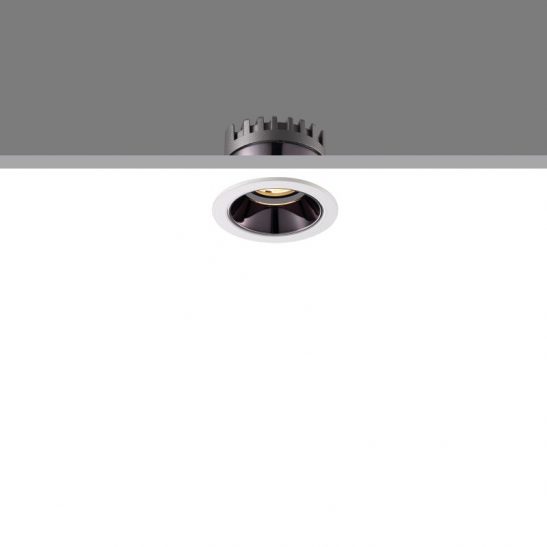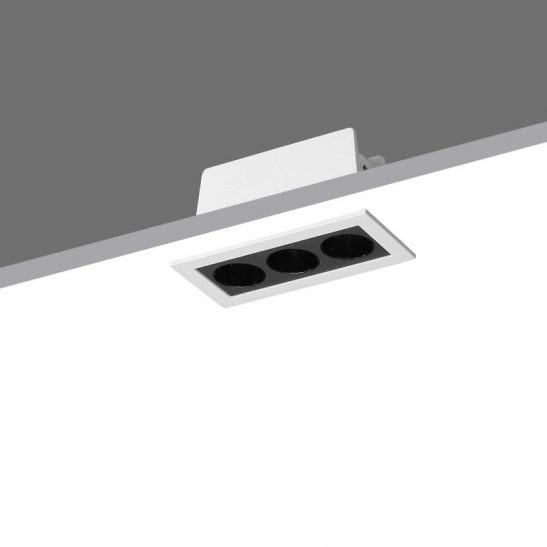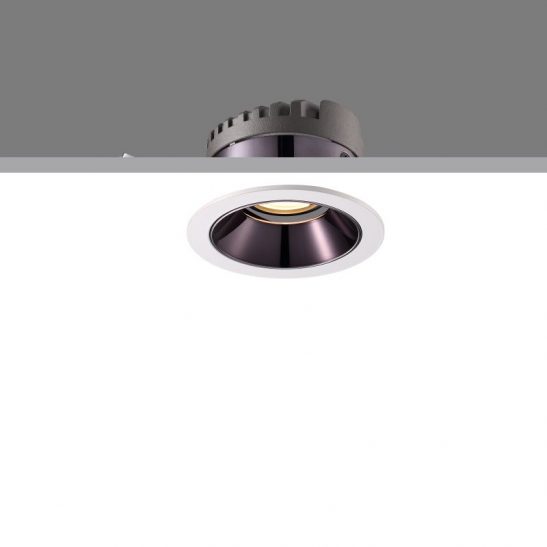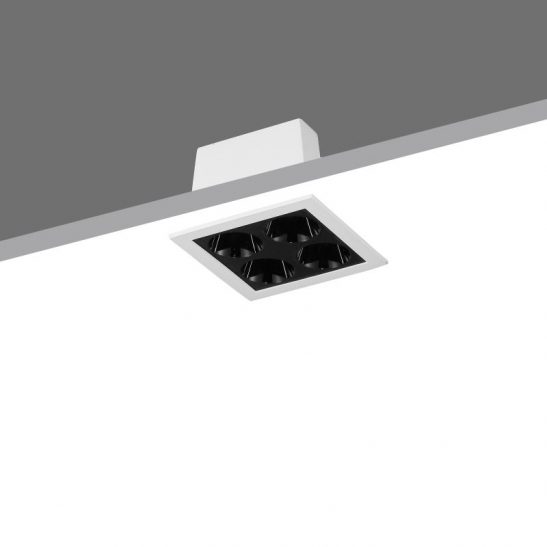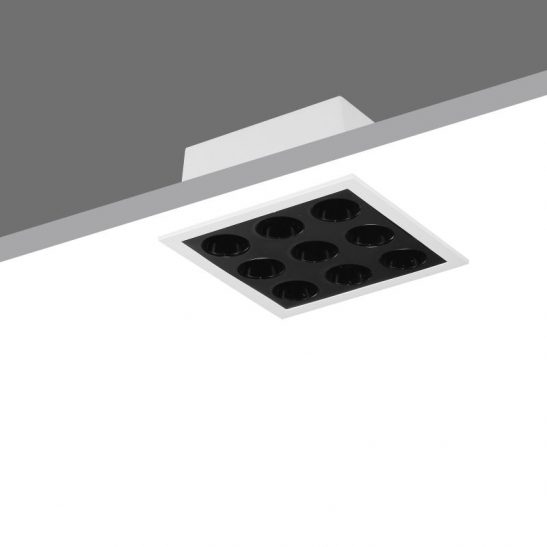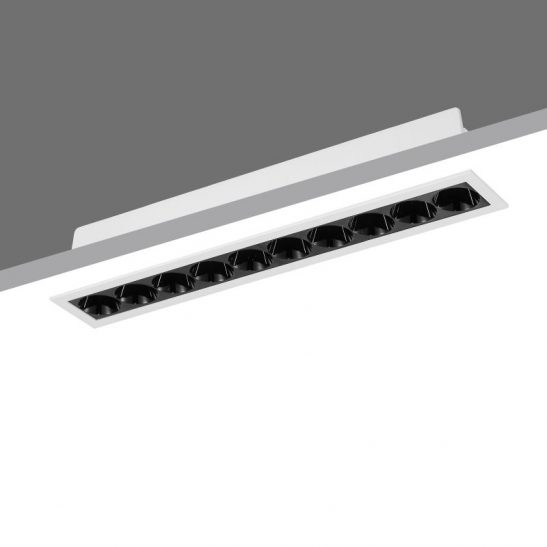Commercial LED Downlights
At Ultra Beam Lighting, we believe in providing the highest quality commercial LED downlights at the most competitive prices. Whether you need office lighting downlights to increase productivity or are seeking shop display lighting solutions to maximise sales, you’ll find the top-tier downlights that you need, right here at Ultra Beam Lighting.
Showing 1–20 of 22 resultsSorted by price: low to high
-
6 Watt Dimmable Ultra Slim LED Downlight Fitting
£25.14 (Excl. VAT £20.95)Select options This product has multiple variants. The options may be chosen on the product pageRated 0 out of 5 -
4 Watt Dimmable Recessed Anti Glare LED Downlight
£30.24 (Excl. VAT £25.20)Add to basketRated 0 out of 5 -
5 Watt Anti Glare Dimmable Recessed LED Downlight
£31.80 (Excl. VAT £26.50)Add to basketRated 0 out of 5 -
6 Watt Dimmable Recessed Anti Glare LED Downlight
£34.74 (Excl. VAT £28.95)Add to basketRated 0 out of 5 -
12 Watt Dimmable Ultra Slim LED Downlight Fitting
£35.04 (Excl. VAT £29.20)Select options This product has multiple variants. The options may be chosen on the product pageRated 0 out of 5 -
9 Watt Anti Glare Dimmable Recessed LED Downlight
£40.20 (Excl. VAT £33.50)Add to basketRated 0 out of 5 -
8 Watt Dimmable Recessed Anti Glare LED Downlight
£41.76 (Excl. VAT £34.80)Add to basketRated 0 out of 5 -
18 Watt Dimmable Ultra Slim LED Downlight Fitting
£46.74 (Excl. VAT £38.95)Select options This product has multiple variants. The options may be chosen on the product pageRated 0 out of 5 -
10 Watt Dimmable Recessed Anti Glare LED Downlight
£46.74 (Excl. VAT £38.95)Add to basketRated 0 out of 5 -
5 Watt LED Dimmable White Recessed Downlight
£47.70 (Excl. VAT £39.75)Add to basketRated 0 out of 5 -
15 Watt Anti Glare Recessed Dimmable LED Downlight
£64.32 (Excl. VAT £53.60)Add to basketRated 0 out of 5 -
12 Watt Dimmable Single Modular LED Downlight
£67.68 (Excl. VAT £56.40)Select options This product has multiple variants. The options may be chosen on the product pageRated 0 out of 5 -
18 Watt Dimmable Recessed Anti Glare LED Downlight
£70.50 (Excl. VAT £58.75)Add to basketRated 0 out of 5 -
20 Watt Dimmable Recessed Anti Glare LED Downlight
£75.00 (Excl. VAT £62.50)Add to basketRated 0 out of 5 -
12 Watt Dimmable Single Modular LED Downlight
£86.88 (Excl. VAT £72.40)Select options This product has multiple variants. The options may be chosen on the product pageRated 0 out of 5 -
10 Watt LED Dimmable Twin White Recessed Downlight
£88.50 (Excl. VAT £73.75)Add to basketRated 0 out of 5 -
30 Watt Dimmable Recessed Anti Glare LED Downlight
£102.54 (Excl. VAT £85.45)Add to basketRated 0 out of 5 -
15 Watt LED Dimmable Triple White Recessed Downlight
£103.80 (Excl. VAT £86.50)Add to basketRated 0 out of 5 -
24 Watt Dimmable Twin Modular LED Downlight
£121.50 (Excl. VAT £101.25)Select options This product has multiple variants. The options may be chosen on the product pageRated 0 out of 5 -
24 Watt Dimmable Twin Modular LED Downlight
£151.68 (Excl. VAT £126.40)Select options This product has multiple variants. The options may be chosen on the product pageRated 0 out of 5

Shop with Confidence

What Are Commercial LED Downlights?
Commercial LED downlights are ceiling lights for commercial spaces that play a big role in the ambient lighting design of a space. Well-placed commercial recessed lighting can make a huge difference in various spaces, such as:
- Exhibition halls
- Hotels
- Offices
- Restaurants
- Retail shops
- Warehouses
Commercial downlights use LED bulbs, which possess many benefits that will be discussed further down. They are versatile fixtures that come in many styles, materials and finishes, so you can easily incorporate them into your space.
Benefits of LED Downlights for Commercial Applications
By choosing commercial downlighting fixtures instead of halogen or incandescent, you will reap a world of benefits unique to this bulb type. Recessed retail lighting for shops provide you with more than just ample illumination. They are also:
- Energy efficient. LED bulbs use 80 percent less energy than halogen or incandescent bulbs. By not having to first create heat to generate light, they use all of their energy for illumination. This makes them far more efficient than standard bulbs.
- Eco-friendly. With a reduction in energy usage, commercial LED ceiling spotlights can help you lessen your environmental impact. This is especially important if you are using ceiling mounted or commercial recessed downlights. In commercial settings, the light runs more often than it might in domestic environments.
- Long lasting. LED bulbs can outlast tens of thousands of hours instead of the 1,000 hours or so of halogen lights. Longer lifespans mean less frequent replacements of bulbs, which can lower your overall costs.
- Cost effective. Because of its lower energy needs, it also requires less electricity to be powered. With a smaller strain on your electrical resources, you may notice a decrease in your energy bills.
- Versatile.Commercial ceiling downlights come in a number of different colour temperature and lumen counts. With so many variations to choose from, you can ensure your shop lighting downlights perfectly match what you envision.
How Commercial LED Ceiling Downlights Enhance Customer Experience in a Retail Setting
As mentioned, choosing commercial adjustable downlights for your shop display ceiling lighting makes for a more comfortable shopping experience for your customers. Eye comfort that LEDs provide reduces eye strain, fatigue, and headaches. It can encourage customers to shop around for longer, since they won’t feel eager to get out of the store.
While they are shopping, large commerical downlights will make it easier to see the products on display. When customers have a clear view at the items they are interested in, they can make more informed choices about buying them. Incorporating commercial adjustable downlights will also allow you to angle the illumination to shine on products that you want to draw extra attention to as well.
Similarly, you can use lighting to lead your customers around the shop. By creating points of interest through purposeful placement of commercial can lights, you can naturally guide the customers to follow certain paths. This way, you can have more people wandering past the items you wish to sell the most, which may increase the chance of actually making the sale.
Lighting is considered to be one of the best ways to set a mood and atmosphere. In your shop, this is important for communicating your brand personality and making the shop a place your customers like to be. Dimmable commercial downlighters are especially good for boutique style shops that require a more cosy and intimate vibe.
Why LED Downlights Are the Best Choice For Commercial Applications
Alongside previously mentioned perks like energy efficiency and cost effectiveness, there are a few other benefits unique to commercial recessed LED lighting for you to consider.
Among them is the light quality and level of control. LEDs provide consistent lighting that does not flicker the way incandescent bulbs often do. The full lighting is provided instantly as well, with no delay between flipping the switch and having the light come on. Since they can be hooked up to smart systems, you can even set them on timers or control them with your voice.
From a human-focused standpoint, LED lights are also thought to help boost focus and concentration, making them the preferred choice for office environments. This is due to their colour temperature options that mimic the light of day, providing similar benefits to natural lighting.
This also translates to more comfortable lighting for your customers as they shop. Commercial down lights are easier on the eyes than flickering incandescent bulbs or too-dim halogen lights. When your customers are comfortable in your shop, they are more likely to spend more time browsing. This could translate to increased sales
Maintenance Tips for Commercial LED Downlighters
Maintaining your commercial recessed light fixtures is important if you want them to last for as long as possible. With high quality lights that are properly maintained, you can make the most out of your fixtures and enjoy them to the fullest.
At the very least, you should walk around the area on occasion and check for any dust or debris buildup on the fixtures. Such debris can accumulate on the fixture which may in turn dim the brightness of the light. To clean them, simply turn the power off and take a dry microfiber cloth to the fixture. Be sure you use soft materials so you don’t accidentally scrape the finish with something too harsh.
While cleaning, you can look for any dislodged or damaged elements of the light. This could be loose components such as the rim or lens, or even wiring that has come loose. Cracks in the housing or the lens itself should be repaired or replaced immediately to preserve the light quality in the area.
During this time, you can check the LEDs and ensure they are still burning at full brightness. If you notice some are dimmer than the others or are flickering.
In the event that you notice any faulty wiring, it is recommended that you have a professional take a look as soon as possible. Tinkering with the wiring yourself if you don’t know what you’re doing runs the risk of electrical shock. It is better to trust a professional to handle it for you and ensure everything is up to code.
How to Choose the Right Recessed Commercial Downlight for Your Application
With so many styles of commercial spot downlights to choose from, the right fixture for you will come down to your needs and preferences. To figure out what those needs might be, consider the following when shopping for your commercial LED can lights.
Purpose and Use Case
When deciding which commercial LED ceiling lights are best, consider exactly what you will be using them for. If you are implementing them as shop display lighting, then you want bright commercial LED ceiling spotlights for shops in particular. Bright lights that you can adjust to shine down and provide clarity on specific products can help you direct attention to the items you want to sell.
For more general retail lighting, you should choose commercial ceiling downlight to provide an even wash of light across the space. This will provide clear visibility and a more welcoming atmosphere for your customers.
Showrooms, on the other hand, need ultra bright lighting, and plenty of it. Choose commercial recessed light fixtures with a cool colour temperature and high lumen count for best results.
Size of the Fixture
How big the light is and where you install it really matters. Opt for a size that works well in the space. For example, smaller shops benefit from more compact commercial LED downlights to reduce clutter. Larger shops, on the other hand, need large commercial downlight fixtures so they don’t get swallowed up in all of that space.
Lumen Counts
Lumens indicate how brightly an LED bulb will shine. Different retail environments will require different lumen counts, especially if you are layering your retail lighting spotlights with other lights. For modern showrooms, opt for lights with a higher lumen count. For more intimate retail shops and boutiques, you can use lower lumen counts.
Style
Your brand has its own personality you want to communicate. Lights can help you do that. The style and finish of the commercial ceiling light you choose should match with the overall aesthetic of your shop. This ensures a streamlined look where nothing feels out of place
How to Choose the Right Colour Temperature for Commercial Downlighters
Colour temperature, or CCT, refers to values that indicate how warm or cool a light is perceived to be. Colour temperature exists on a scale between 1,000 and 10,000 units Kelvin. Toward the top, you’ll find the cooler light colours. The bottom of the spectrum is where you’ll find warmer colours.
The temperature that is best for you will depend on your needs and the mood of the area.
Cool Light Use Cases
For showrooms and electronics shops, cool white lighting that is 6000K or above is ideal. This provides a bright, energetic and modern feel while showcasing the electronics in a modern way. These also tend to be preferred in jewellery shops where maximum sparkle and shine is important.
In offices, some people prefer to have energizing cool lights in the space. Others may opt for warmer colour temperatures that offer a more diffused light. A good balance would be a neutral white colour, such as in the range of 3500K.
For clothing boutiques and other such shops that need a more inviting atmosphere, warm white lights are best. Lights with colour temperatures between 3000K and 3300K are ideal for creating a soft, diffused light that is still bright enough to easily see by.
In a hotel, you will want to choose warm white commercial down lights. Warm lighting is more inviting and easier on the eyes, which is important for road-weary travellers. This will help you create a welcoming space for your guests to unwind.
Whatever you choose, ensure you are only using one or the other. Having cool and white lights shining in the same place can cause unappealing clashing of colours. This can be rather abrasive and may be unpleasant to behold.
Why Use Dimmable Commercial LED Downlight Fixtures?
Dimmable commercial downlighting can totally transform the atmosphere and functionality of a business. They bring with them total flexibility, versatility and energy saving benefits, making them attractive to shop owners of all sub-industries.
One of the biggest draws to commercial LED downlight fixtures that dim is the energy savings–and the subsequent cost savings. By reducing the brightness on your surface mounted or recessed commercial downlight, you are also reducing the amount of power being used. Not only is this good for the environment, but it’s good for your budget as well.
Using less energy also means extending the life of the LED bulb. Running commercial spot downlights below their max output reduces the stress that is placed upon them, which may prolong the life of the bulb above 50,000 hours. This way, you can even save money on bulbs by not having to replace them as often.
In terms of comfort and productivity, dimmed commercial can lights help here as well. They are gentler on the eyes, which can improve employee comfort and therefore productivity. Furthermore, choosing light temperatures in the cool white range may also enhance their productivity levels.
Which Beam Angle for Commercial Recessed Downlighting?
Modular LED downlights come in a number of beam angle options, each one with its own benefits and perks. The beam angle determines the effect that the light has on the space.
Narrow Beams
Narrow beam angles between 15 and 30 degrees offer a focused spotlight style. These are high-intensity beams that have sharp, concentrated edges and work well for retail display cabinets. Oftentimes, you will notice this beam angle with tilting commercial downlight, as they allow you to be more specific with the direction of your light.
Medium Beams
Medium beam angles between 30 and 45 degrees provide a balanced spread to give general lighting in a space. The moderate spread of illumination makes it good for offices and hallways.
Wide Beams
Wide beam angles between 60 and 120 degrees give even illumination over a wide area of space. The diffused, soft edges have a low intensity and are commonly used for ambient lighting.
When choosing the beam angles, avoid common mistakes such as:
- using narrow beam angles in rooms with low ceilings, as those can create hotspots
- overlapping wide beams, as this can cause over-illumination and wastage of energy
- ignoring the optics of reflectors, as these can modify the spread of the beams and give unwanted results
How to Decide on the Correct Lumens to Use for Your Application
The lumen count of the commercial modular LED downlights you choose matters. Lumens refer to the brightness level that is created by a given bulb. It measures the total visible light that is emitted by a bulb, compared to watts which simply measure energy output.
Knowing the lumen count to use comes down to understanding a few key elements of your space:
- CEILING HEIGHT AND ROOM SIZE. Larger rooms that have high ceilings will often need a higher lumen count.
- TASK NEEDS. Consider what sort of activities will be taking place in the room. Will it be an office that needs brighter light, or will it be a lounge area that needs softer ambient lighting?
- LAYOUT OF THE LIGHTS. The beam angle and the spacing of the lights will play a role in the number of lumens that are required.
As you can see, the number of lumens that will be required will change from room to room, depending on the needs of the space. Even though each space will have its own requirements, you can follow a basic rule of thumb as a guideline.
Generally speaking, there is a recommended lumen level for different environments that you can follow:
- General office spaces should have 800 to 1,200 lumens per fixture
- Retail showrooms should 1,200 to 2,000 lumens per fixture
- Warehouses should have 3,000 to 5,000 lumens per fixture
- Hotels lobbies should have 700 to 1,000 lumens per fixture
- Hospitals should have 1,000 to 1,500 lumens per fixture
- Schools should have 900 to 1,300 lumens per fixture
- Restaurants should have 500 to 800 lumens per fixture
Adjustable commercial downlight fixtures come in a number of different lumen counts that you can mix and match to suit your needs for the space. Pay attention to the stated lumen output to get the most out of your fixtures. By being mindful of what you are installing, you can prevent over-lighting the space while also ensuring there are no dark or shadowy areas that are left untouched.
What is CRI and Why is it Important for Downlights in a Commercial Application?
CRI, or colour rendering index, is a way to discuss how accurately a light shows the colours of the items it shines upon. It is rated on a scale between 0 to 100, where the higher the number, the more accurate the colours will be.
A high quality CRI of 90 or above gives colours a true to life and vibrant appearance. Lower CRI ratings can make colours seem duller and less accurate.
Therefore, CRI matters, especially in commercial environments. By having accurate product colours, you will be showing what your items look like in and out of the shop. This is crucial for items like clothing if you want to minimise the number of returns. A rating of 90 or above is recommended.
In healthcare facilities, it helps to have high CRI ratings to accurately assess diagnostic samples, skin tones and wounds. Similarly, it creates an environment that looks more natural and is therefore more comfortable for the patients being treated there. A rating of 90 or above is crucial.
In offices, quality lighting and a good CRI rating can reduce eye strain. This can make working more comfortable for your employees, which may also enhance their productivity. It is recommended you have a minimum CRI of 80 or above.
In hospitality settings, such as hotels and restaurants, good CRI ensures things like food look more appealing and fresh. It can also create a more flattering look on skin, great for hotels that have spas and gym areas.
How To Use Commercial Recessed Downlights in a Hotel
When discussing hotel lights like commercial spot downlights, lobby lighting is usually the main design element being considered. There are other areas in a hotel you may want to light, though, such as reception areas, restaurants, corridors and conference rooms. Below are some tips for incorporating commercial LED recessed downlights into your hotel:
- PICK THE RIGHT LIGHT – Choose commercial downlighting fixtures that fit in with the rest of your hotel’s decor as well as lights that suit the needs of your space. For instance, select adjustable downlights in a lobby to highlight artwork or fixed downlights in hallways for even lighting.
- PLAN OUT DIFFERENT AREAS – Divide the hotel up into different areas such as the ones mentioned above and think about what lights you need for each one.
- HOSPITALITY LIGHTING TRENDS – Pay attention to current trends in the industry to ensure you are laying out a stylish and inviting modern hotel lighting scheme for guests.
- LAYER THE LIGHTING – Add accent, task and ambient lighting to create a balanced, well-lit effect.
- ACCENT LIGHTS – Recessed commercial adjustable downlights can be used as accent lighting for architectural details, art or other decorative aspects of the space.
- TASK LIGHTING – Add commercial LED ceiling lights near work areas, vanities, conference tables, reception desks and other task-heavy areas to ensure adequate lighting to complete these tasks.
- AMBIENT LIGHTING – Incorporate commercial LED downlights as the main overhead lighting to provide a wide spread of illumination throughout the room.
- OPT FOR THE BEST COLOUR TEMPERATURE – For modern hotels, colour temperatures that are cooler, in the 4,000k to 5,000k range, are best. If you want something more relaxed and cosy, 2700k to 3000k are generally believed to be best.
How To Use Commercial LED Downlighters in an Office
When it comes to office lighting, commercial recessed downlights are also beneficial. Recessed office downlights can be incorporated into any office layout lighting ideas by keeping the following in mind:
- CONSIDER THE LAYOUT – Get an idea of where the workstations, corridors, break rooms and meeting rooms are in relation to each other. Plan the types of light that each space will need.
- ZONE THE LIGHTS – You can add different commercial ceiling lights to different zones depending on the functionality of each space.
- FIGURE OUT BRIGHTNESS LEVELS – Figure out how much light you want for each area in the space, as they are likely to differ. For example, workstations will usually require more light than a breakroom.
- SPACING AND PLACEMENT – Ensure that the lights are evenly distributed by placing them strategically along the ceiling. Consider things such as furniture placement and ceiling height.
- LIGHT UP MEETING ROOMS – Use commercial adjustable downlights in meeting spaces to provide spotlights on whiteboards and presentation areas. Pendant downlights are also good for such conference areas.
- HALLWAYS AND CORRIDORS – Commercial recessed light fixtures in corridors can provide even and uninterrupted illumination to make it easier to navigate these high-traffic areas.
- CHOOSE THE RIGHT COLOUR TEMPERATURE – To foster a more comfortable and productive environment, it is recommended that you choose cooler temperatures between 3500k and 5000k.
How To Use Commercial Recessed Downlights in a Retail Store
Retail commercial downlights follow the same layered lighting rule as other types of lighting. This means incorporating ambient, task and accent lighting in the shop.
- AMBIENT – Modular recessed downlights make a great choice for retail lighting. This can allow you to spread the light out over the entire store while maintaining a balanced look.
- ACCENT – Accent lighting can draw attention to certain areas of the store, displays or individual products. Using commercial spot downlights, you can easily highlight areas that you want customers to be drawn toward. Accent lighting can also be used to set a mood in a shop if you want something more atmospheric.
- TASK – Modular LED downlights for customer service areas or checkouts can ensure ample lighting for employees to do their jobs.
- EMPLOY THE BEST COLOUR TEMPERATURE – Use cool, bright lights around the 3500k to 4500k spectrum to ensure the shop is well lit and the products are easy to see.



